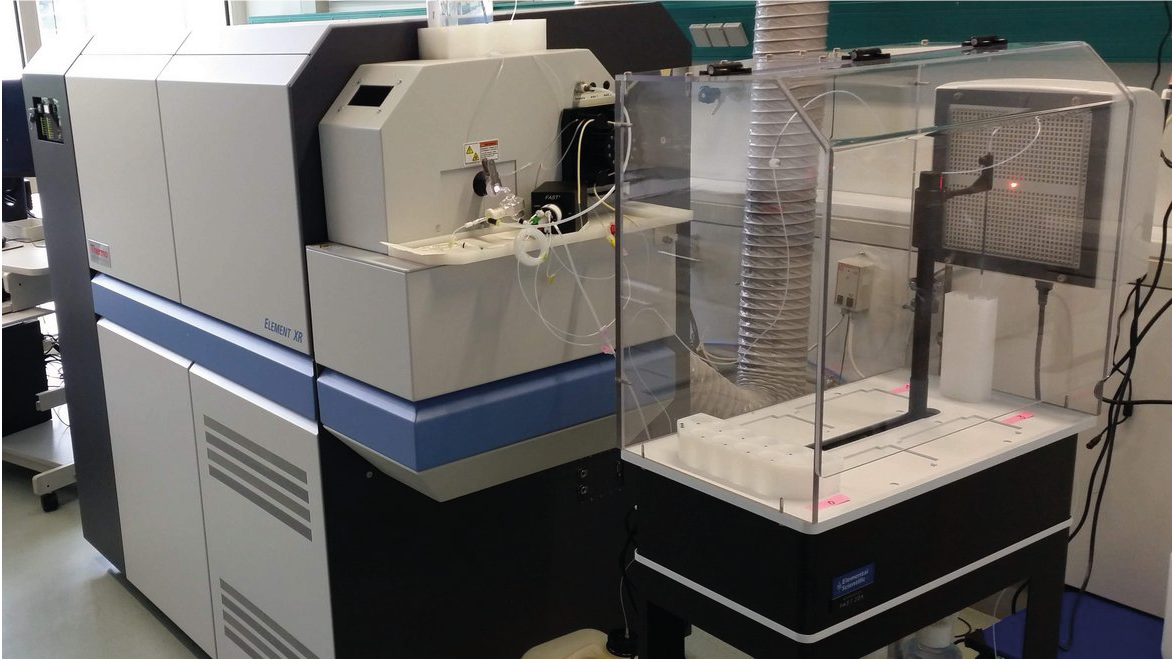ICP-MS Lab
Contact:
Web:
Infrastructure belongs to:
The ELEMENT 2XR is a high-resolution sector field mass spectrometer (HR-ICP-MS) with inductively coupled plasma as an ion source. It is used for the quantitative analysis of element concentrations or isotope ratios. It offers excellent results even for complex problems and demanding samples. The Elements 2XR combines a configuration that is primarily characterized by the following features:
- Faraday detector and an SEV detector (secondary electron multiplier), thereby extending the dynamic detection range.
- Measurements of different concentration ranges in a single analysis.
- Excellent detection limits below 1 ng/l.
- The typical mass-independent sensitivity for a HR-ICP-MS results in an improvement in the stability and reduction of the detection limit over the whole mass range from Li to U.
- Three different mass resolutions can resolve almost all elements without interference.
Routine analyses after acid digestion of rocks can be done for the following elements: Li, Be, Sc, V, Cr, Mn, Co, Ni, Cu, Zn, Ga, Ge, Rb, Sr, Nb, Mo, Cd, Sn, Sb, Cs, Ta, Pb, Bi, Th, U as well as REE: La, Ce, Pr, Nd, Sm, Eu, Gd, Tb, Dy, Ho, Er, Tm, Yb, Lu (The elements of the platinum group can be determined following an elaborate pre-concentration technique.)
Routine analyses in aqueous solutions can be done for the following elements: Na, Mg, Al, K, Ca, Fe and Li-U. Analysis of PGEs in aqueous solutions, isotope ratios and other analyses not listed above, can be arranged upon request.
The ICP-MS Lab is associated to the ElMiE Lab. Information on how to apply for analyses and the general terms and conditions can be found here and here.
Categories
Disciplinary Keywords
Instrumentation
Laboratory instrumentation
Instrument
-
Inductively Coupled Plasma Mass Spectrometer
Inductively Coupled Plasma Mass Spectrometry (ICP-MS) is one of the fastest growing inorganic analytical technologies of the 21st Century. Newly developed Time of Flight instrumentation is augmenting more traditional quadruple and magnetic sector based instrumentation. Laser ablation, graphite furnace, liquid and gas chromatographic interfacing has facilitated the analysis of a significantly increased variety of sample types, enabling the determination of up to sixty elements in samples as small as 10 micro-meters in diameter and improved the resolution and detection limits of organo-metallic species analysis in such matrices as foodstuffs, water, sediment and environmental samples. Additional information available at "http://www.curtin.edu.au/curtin/centre/cems/icp_ms.html" [Summary provided by CEMS] (Source: Global Change Master Directory (GCMD). 2023. GCMD Keywords, Version 16.3. Greenbelt, MD: Earth Science Data and Information System, Earth Science Projects pision, Goddard Space Flight Center (GSFC) National Aeronautics and Space Administration (NASA). URL (GCMD Keyword Forum Page): https://forum.earthdata.nasa.gov/app.php/tag/GCMD+Keywords)
Relationships
- is part of
- is related to
